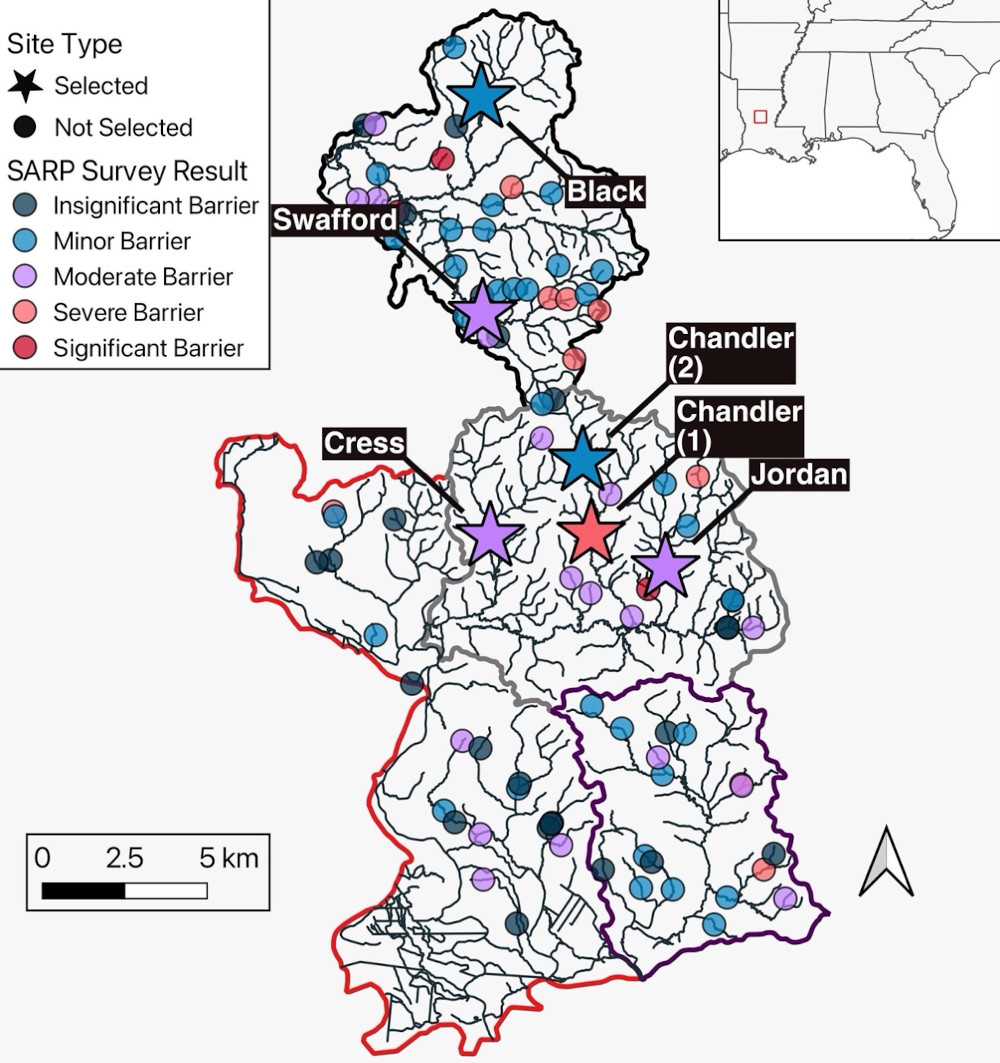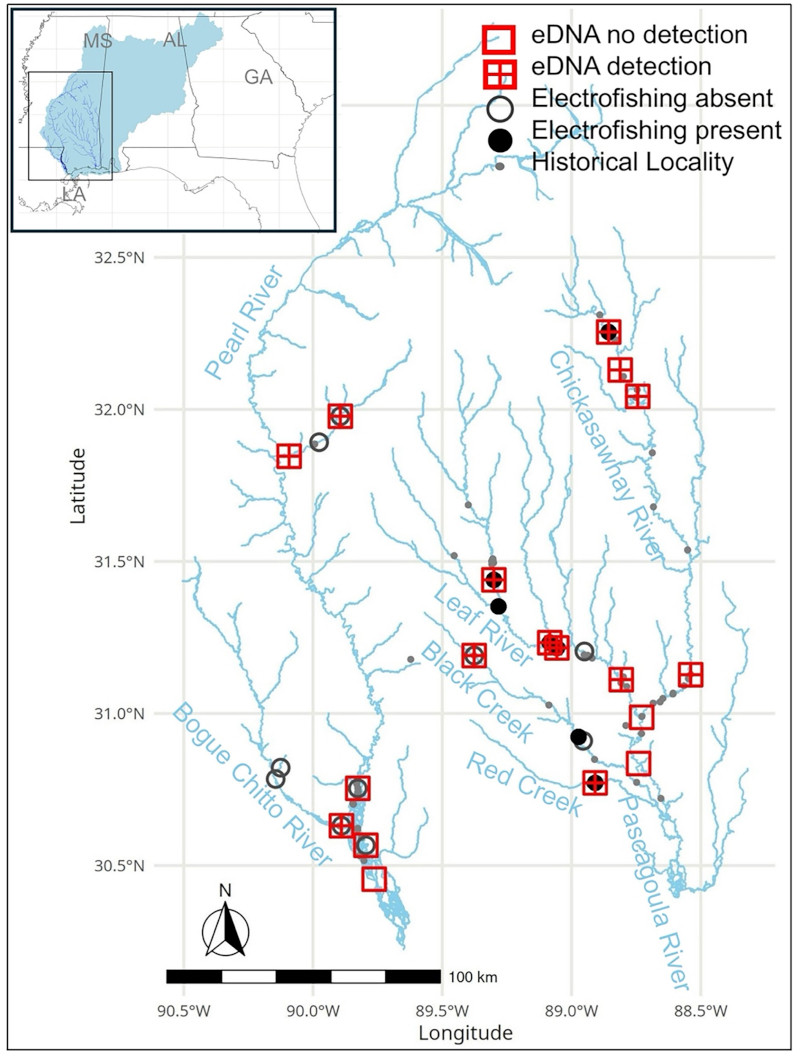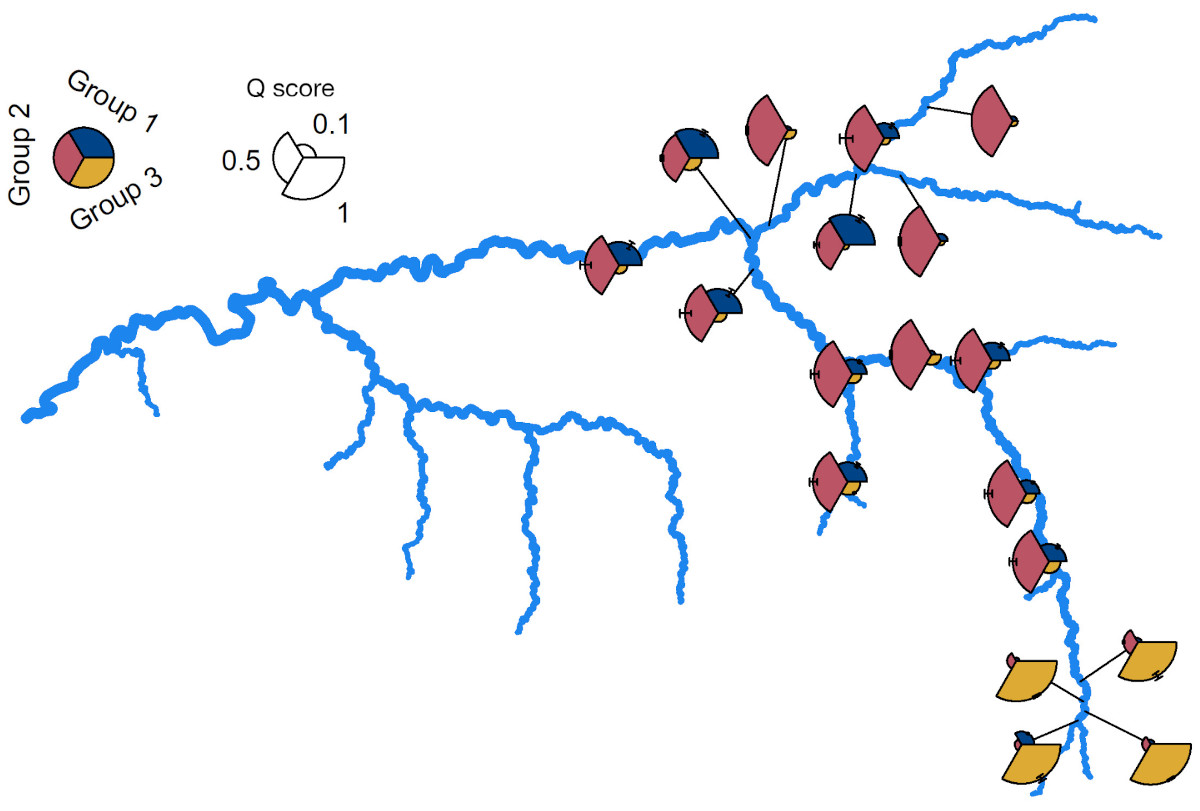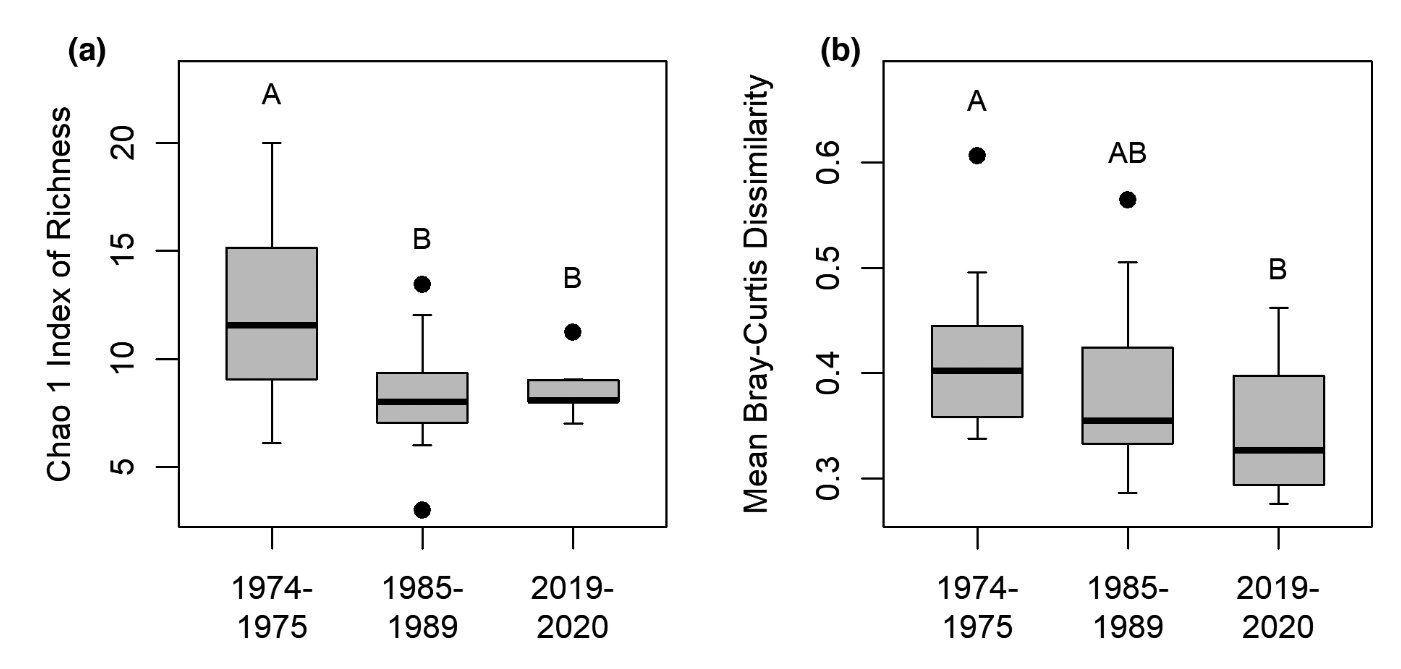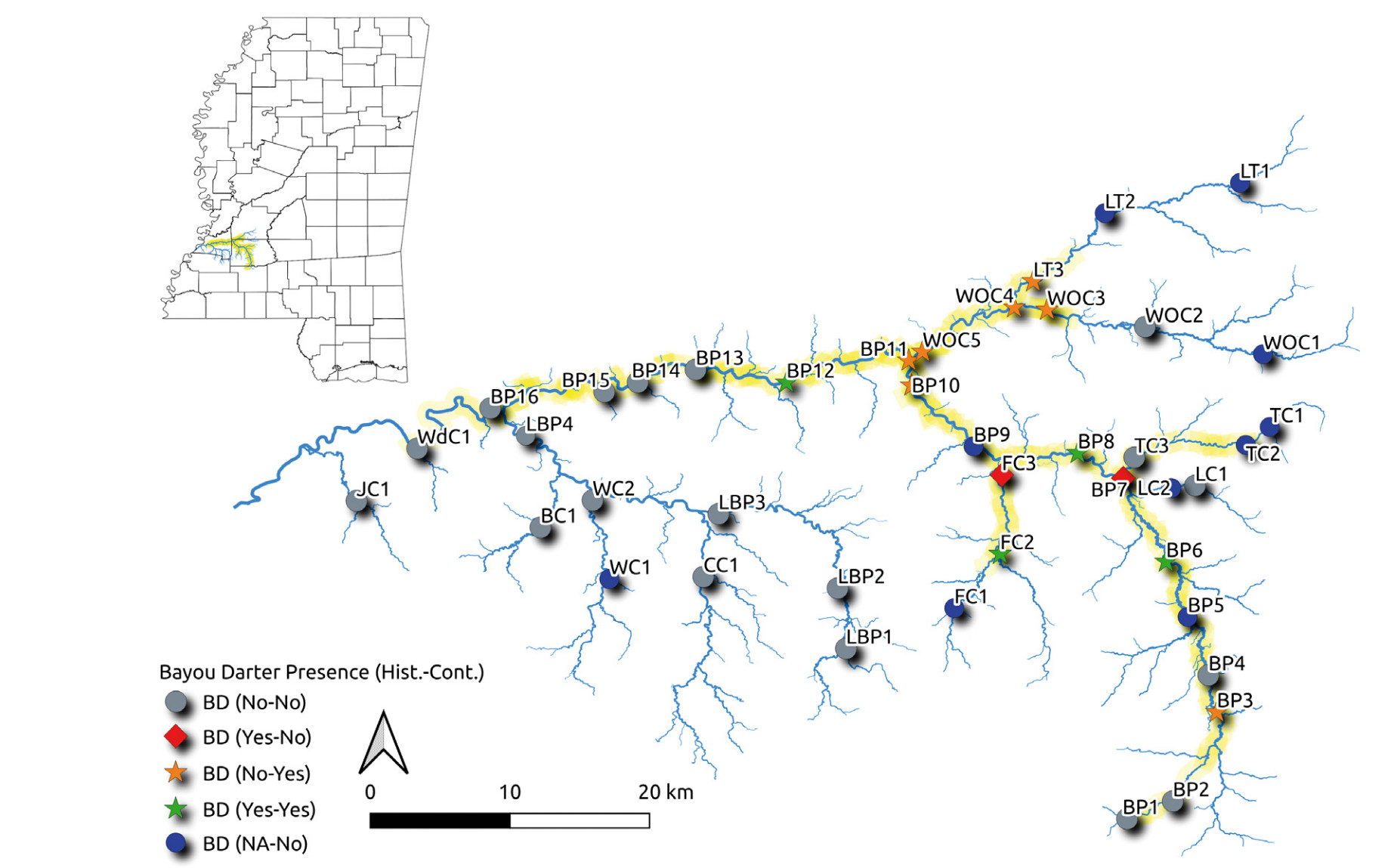Rimmer, L.H., J.F. Schaefer and M. Warren. 2025. Leveraging a spatiotemporally large dataset to test predictions of life history theory in stream fish communities Ecology of Freshwater Fish. 41:2006-2016
Identifying the mechanisms that underly how organisms respond to current and expected hydrologic alterations is essential to understanding the effects of climate change on riverine systems. Life history theory is one such mechanism and forms clear predictions about how certain traits (e.g. body size) or groups of traits (strategies) will be selected for by hydrological conditions. However, few researchers have tested hypotheses informed by life history theory across large spatial and temporal scales simultaneously, or considered how selection acts on both individual traits and strategies. Our goal was to use a stream fish community dataset spanning five river basins and over two decades, to test the hypothesis that 1) individual traits would be selected for by environmental conditions, and 2) that life history strategies would be selected for by hydrological conditions. To test the first hypothesis we used a permutation procedure to compare functional beta diversity between observed and randomized datasets. To test the second hypothesis across life history strategies we first fit beta-binomial models with life history strategy (identified through archetype analysis) as the dependent variable and predictors of streamflow as independent variables, and then identified interpretable models using model selection. Our results did not support the first hypothesis or the second hypothesis within both periodic and opportunistic strategies. However, we did find evidence that equilibrium strategists were selected for by less variable hydrology. Our results fill an important data gap within the southeastern U.S. and suggest that that the influence of life history traits on community structuring is not as influential as within previous studies. We hypothesize that this is primarily due to the spatiotemporal scale and a lack of environmental extremes within the dataset. Future studies should expand on the current study by investigating how selection may act differentially on individual traits and life history strategies.
Stearman, L.W., J.F. Schaefer and S.R. Clark. 2025. Early channel evolution relates to fish community resource use in the Gulf Coastal Plains of North America Ecological Applications.
Recent work has highlighted the importance of complex, multi-threaded, sediment and wood-retentive channels (“stage 0” channel morphology). Widespread channel evolution from a variety of perturbations threatens these crucial habitat types by shifting river channels to higher-energy, more erosive environments. In this paper we expand our understanding of the effects of loss of these resources with a quantitative, multi-decadal dataset of fish and habitats across National Forest sites in the Gulf Coastal Plains of Mississippi. Channel morphological analysis indicated a gradient from incised, wide, shallow channels with coarse substrates typical of advanced channel evolution processes to relatively unincised, narrower, deeper, more sediment and wood-retaining channels typical of stage 0 conditions. Multivariate analysis of community-scale resource use suggested a gradient from communities which predominately use resources available in more erosive channels to those found in more stage 0 type channels. Regional constrained ordination, intra-watershed meta-analyses, and inter-watershed aggregate analyses all linked the channel morphology erosion gradient to community-scale resource use gradients. Measures of functional vs taxonomic diversity suggest a loss of functional but not taxonomic diversity. Our results demonstrate links between resource types available in channels and how communities structure themselves based on resource use. Further, our results suggest that this initial stage of channel evolution has a different outcome than later stages, which filter out habitat specialists in favor of generalist species. We integrate existing studies of fish community response to channel evolution with our data to build a broader understanding of the process and its ecological impacts in the Mississippi Embayment. Our results have implications for biodiverse and imperiled fish faunas globally.
Rimmer, L.H., S.R. Clark and J.F. Schaefer. 2025. Assessing and Optimizing a Rapid Road-Crossing Protocol for Aquatic Organismal Passage River Research and Applications. 41:2006-2016
For decades, managers have sought to mitigate the effects of fragmentation on wildlife. In aquatic ecosystems, fragmentation strongly affects headwater streams due to the structure of riverine networks and the abundance of road crossing culverts. Standardized road crossing assessments offer an alternative to historical methods in facilitating the identification and prioritization of barriers for restoration. However, the ecological relevance of these assessments is seldom empirically investigated, and most assessments assume homogenous environmental and biotic conditions observed during snapshot surveys. Our goal was to assess both the efficacy and assumptions of the widely adopted Southeastern Resource Aquatic Partnership’s (SARP AOP) Road Crossing Assessment for predicting fish passage. We used model selection of generalized linear mixed models to compare SARP AOP scores to observed movement calculated through mark-recapture. We also compared the SARP AOP score with a version of the score modified to better reflect local environmental conditions. Our results suggest a lack of support for the efficacy of the SARP AOP score in predicting fish passage and only marginal improvements under the modified score within low gradient headwater streams in central Louisiana. This study is an important first step in our ability to modify standardized score calculations to increase efficacy without additional surveys. Regardless of the scoring framework’s efficacy, standardized road crossing surveys remain highly useful in collecting information related to potentially harmful structures (i.e., failing infrastructure). Future studies should further explore how to improve the efficacy of these assessments, which represent a promising tool to facilitate efficient and effective restoration.
Daun, N., A. Fearing, R. N. Lehman, C. L. Gauci, M. Hansen, J. D. Jones, S. M. Toepfer, B. L. Huerta-Beltrán, E. M. Humphreys, J. F. Schaefer, and N. M. Phillips. 2025. Rare or Rarely Sampled? Electrofishing and Environmental DNA Surveys of the Imperilled Freckled Darter Percina lenticula. Aquatic Conservation: Marine and Freshwater Ecosystems 35:e70165.
The southeastern (SE) United States is a biodiversity hotspot for freshwater fishes, with the darters (Percidae) comprising a large portion of the diversity. The endemic Freckled Darter Percina lenticula was once found across numerous drainages in the SE United States; however, human modifications to waterways have caused local declines to the extent that the species is ‘critically imperilled’ in parts of its range. The putative habitats of P. lenticula pose challenges for traditional sampling techniques, contributing to a paucity of data related to its status, distribution, and abundance across much of its range. This study assessed the occurrence and distribution of P. lenticula in the Pearl and Pascagoula River drainages using electrofishing and eDNA techniques. In the Pascagoula drainage, P. lenticula appears to have a broad distribution, being found via both survey approaches in all tributaries sampled. P. lenticula was detected in the Pearl River drainage for the first time since 1977 via eDNA surveys, but none were found in electrofishing surveys. This indicates the continued survival of P. lenticula in the Pearl River drainage, but they may occur in more localised areas and/or in lower abundances than in the Pascagoula River. Additional spatially comprehensive eDNA surveys in the Pearl River drainage would support future electrofishing surveys to definitively identify locations of remaining populations and estimate abundance(s). Similar surveys should occur across the SE United States to support an updated assessment of the conservation status of P. lenticula, shedding light on whether (and where) the species is rare, or rarely sampled.
Stearman, L., B. Kreiser, and J. Schaefer. 2025. Unexpected population genetic structure in Bayou darter Nothonotus rubrus in the geomorphically dynamic Bayou Pierre, Mississippi, USA. Endangered Species Research 56:159–172.
Habitat fragmentation reduces gene flow and population resiliency. Fragmentation can contribute to localized extinctions, and for small-range taxa, range-wide extinction. Accelerated erosion in streams and rivers may fragment habitats for habitat-specialist species by greatly altering river mainstems, pushing many taxa into isolated tributaries. In this paper, we examine patterns of genetic structuring in the federally threatened and endemic Bayou darter Nothonotus rubrus to assess whether patterns of erosion are causing fragmentation of populations. Patterns of heterozygosity support the hypothesis of recent colonization of upper White Oak Creek. Analysis using STRUCTURE software yielded unexpected results: a population isolated above an erosional feature, a population widespread throughout the watershed, and evidence of introgression between 2 of 3 genetic clusters. Multivariate analyses support STRUCTURE in suggesting evidence for 3 genetically distinct populations. Effective population size analysis found estimates of abundance to be spatially concordant with recent field studies. Our results demonstrate unexpected population structuring in N. rubrus, potentially due to populations becoming separated by features related to in-channel erosion. The amount of local adaptation related to this differentiation is unknown; however, conservation efforts and efforts to augment existing populations should take into account genetic variation and potential local adaptation. We recommend next steps for further exploring genetic variation and potential conservation strategies for this species.
Stearman, L. W., and J. F. Schaefer. 2024. Altered metapopulation dynamics in a headwater specialist in geomorphically dynamic catchments Freshwater Biology. 69:1203–1217
- Human activities have widely disrupted the spatial ecological processes criti cal for population and ecosystem integrity. Local effects of altered sediment regimes in rivers are well explored, but how they impact connectivity at a catchment scale is less explored. In this paper we document evidence for al tered metapopulation dynamics for a headwater specialist, blackspotted top minnow (Fundulus olivaceus) in catchments with geomorphically dynamic river mainstems.
- We quantified decade-scale patterns of fluvial geomorphic activity via plan form analysis of historical and recent aerial imagery, and patterns of gene flow in F. olivaceus via analysis of single nucleotide polymorphisms, identified by genotype-by-sequencing.
- Mainstem streams narrowed and increased in sinuosity, probably in recovery from historic flood events. Substantial variability in response indicated underlying differences due to differential disturbance history and catchment sensi tivity to change.
- Multiple analytical approaches all found geography to be a major factor in ge netic structuring among catchments. Metrics of genetic differentiation and heterozygosity for F. olivaceus within catchments were related to the degree of geomorphic change inferred from a multivariate composite metric. Catchments with more geomorphic change tended to have more population structuring.
- Five populations assigned to adjacent catchments. Analysis of heterozygosity in presumed donor, recipient, and mis-assigned catchments indicated founder effects in recipient catchments and probable subsequent allopatric recolonisa tion following local extirpations. 6. Our results demonstrate complex nonlocal effects of channel evolution on metapopulation dynamics in a pool-dwelling non-lithophilous headwater specialist. Our integrative approach allows strong insight into deeper effects of geomorphic processes on aquatic ecosystems. F. olivaceus is ecologically dissimilar to taxa traditionally anticipated to respond to sediment- related disturbances and demonstrates how broader channel morphological change can affect habitats beyond sedimentation of the stream bed.
Duvernell, D. D., N. S. Remex, J. T. Miller, and J. F. Schaefer. 2023. Variable rates of hybridization among contact zones between a pair of topminnow species, Fundulus notatus and F. olivaceus. Ecology and Evolution 13:e10399.
Pairs of species that exhibit broadly overlapping distributions, and multiple geographically isolated contact zones, provide opportunities to investigate the mechanisms of reproductive isolation. Such naturally replicated systems have demonstrated that hybridization rates can vary substantially among populations, raising important questions about the genetic basis of reproductive isolation. The topminnows, Fundulus notatus and F. olivaceus, are reciprocally monophyletic, and co-occur in drainages throughout much of the central and southern United States. Hybridization rates vary substantially among populations in isolated drainage systems. We employed genome-wide sampling to investigate geographic variation in hybridization, and to assess the possible importance of chromosome fusions to reproductive isolation among nine separate contact zones. The species differ by chromosomal rearrangements resulting from Robertsonian (Rb) fusions, so we hypothesized that Rb fusion chromosomes would serve as reproductive barriers, exhibiting steeper genomic clines than the rest of the genome. We observed variation in hybridization dynamics among drainages that ranged from nearly random mating to complete absence of hybridization. Contrary to predictions, our use of genomic cline analyses on mapped species-diagnostic SNP markers did not indicate consistent patterns of variable introgression across linkage groups, or an association between Rb fusions and genomic clines that would be indicative of reproductive isolation. We did observe a relationship between hybridization rates and population phylogeography, with the lowest rates of hybridization tending to be found in populations inferred to have had the longest histories of drainage sympatry. Our results, combined with previous studies of contact zones between the species, support population history as an important factor in explaining variation in hybridization rates.
Stearman, L. W., and J. F. Schaefer. 2023. Fluvial geomorphic evolution and stream fish community trajectories in the Bayou Pierre, Mississippi, U.S.A. Freshwater Biology 68(11):2011-2026.
- Human activities have often altered sediment dynamics in rivers, leading to aquatic habitat degradation. The dominant paradigm in fish–sediment interactions focuses on excessive fine sediments as indicators of habitat and water quality degradation. In contrast, geomorphologists have provided frameworks linking altered sediment dynamics to much broader and more complex changes to channel morphology and stream habitats across spatial scales.
- In this paper we use an interdisciplinary approach with historical and contemporary channel morphology and fish community datasets to examine how altered sediment dynamics have affected stream fish community evolution in the Bayou Pierre, Mississippi, U.S.A.
- Erosional process regimes have advanced upstream consistent with models of knickpoint propagation and channel evolution, leaving most of the catchment in a state of increased sediment transport and local sediment deficits. Fish communities in modern samples have less α and β diversity and fewer habitat specialist taxa than in historical samples.
- Whole-community analysis via non-metric multidimensional scaling found a strong gradient of homogenisation towards a fauna comprised of small-bodied taxa adapted to large rivers.
- Comparisons of community and geomorphic change on this gradient found that reaches that transitioned between process regimes had more community change, and that local habitat factors relating to advanced channel evolution were strongly positively related to total community change.
- These results demonstrate that a catchment-scale geomorphic analysis provided a strong tool for understanding fish community change on a decadal scale. Our findings further demonstrate concordant ecological responses to a complex sequence of disturbances and suggest that a broader view of sediment dynamics offers a rich toolkit for ecological analyses.
Hubbell, J. P., J. F. Schaefer, and B. R. Kreiser. (2022). The influence of habitat characteristics on the occupancy and dispersal of two headwater fishes in a dendritic network. Ecosphere 14:e4388.
Stearman, L. W., and J. F. Schaefer. 2022. Long‐term minnow community trait shifts and metacommunity dynamics in a geomorphically unstable river. Ecology of Freshwater Fish 31(4):662-674
Ecological disturbances may affect both habitat connectivity and heterogeneity, changing the dominant metacommunity processes affecting local communities. Altered fluvial sediment dynamics in rivers experiencing headcutting and accelerated erosion may foster morphologically unstable reaches in which supplies of habitat forming materials are spatially and temporally unpredictable. We hypothesise such environments will select for species with traits which promote dispersal or rapid resource use. We tested this hypothesis using historical and recent datasets from a biologically and functionally diverse taxonomical group, minnows (Leuciscidae and Cyprinidae) in the Bayou Pierre, Mississippi. Local communities decreased in both α and β diversity over time. Spatial autocorrelation of communities was consistently high through time, and more strongly related to regional community structure than local habitat variables in contemporary data. Communities shifted towards species with larger body sizes, less parental care, shorter age at maturity and higher fecundity. Communities also shifted towards more generalist species with lower potential trophic positions, and keystone species declined. Our data support the hypothesis of community level shifts towards species with dispersal trait syndromes and opportunistic resource utilisation. These shifts have led to a decrease in ecological complexity and overall homogenisation of minnow communities in the geomorphically evolving Bayou Pierre mainstem. The Bayou Pierre presents a unique window into ecological dynamics in a watershed characterised by altered sediment dynamics and sediment loss, in contrast to the large body of literature examining systems with increased sedimentation. These insights demonstrate the importance of studying the full range of fluvial sediment dynamics, including how broader processes of loss and transport may affect long term habitat stability, persistent trait syndromes and metacommunity dynamics.


